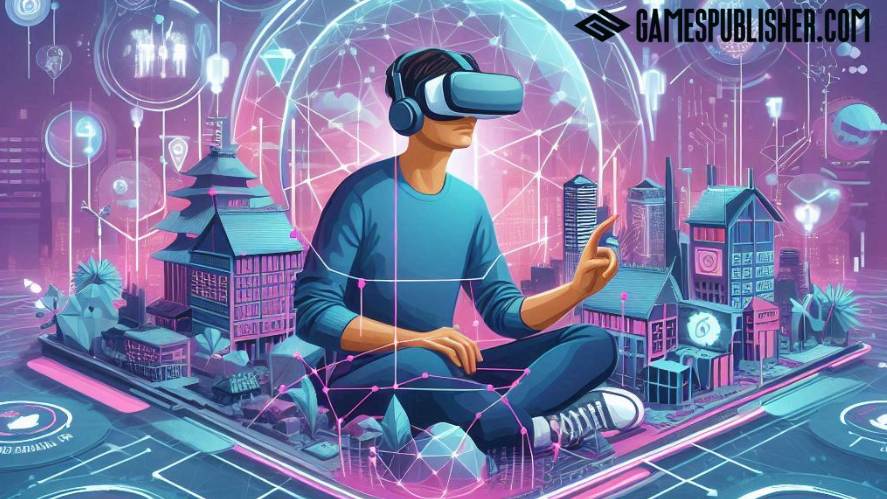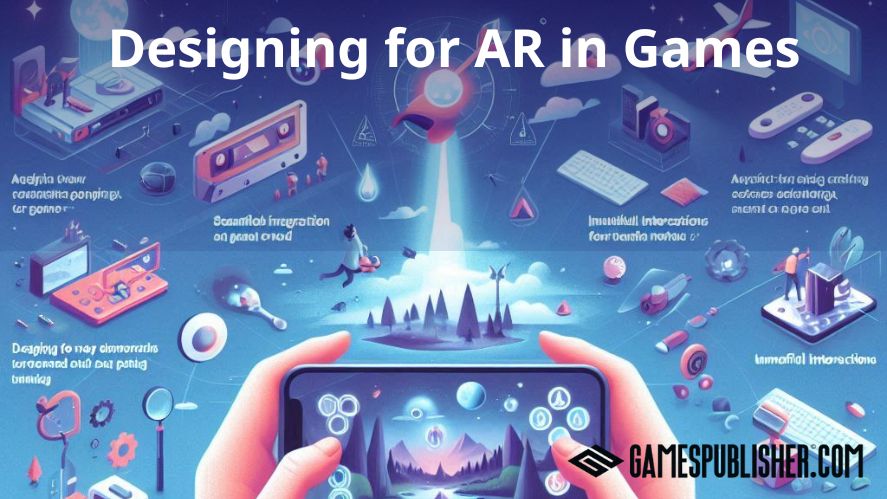Augmented Reality (AR) is an innovative technology that places digital items directly into the real environment.
Due to its ability to generate digital information in the actual environment, AR is revolutionizing the gaming industry and how games are being played.
For game developers, publishers, and especially Gamespublisher.com readers, understanding AR integration is critical to staying ahead in this increasingly competitive market.
In this article, let’s go through the basic concepts of AR gaming and learn more about its impacts on mobile and console platforms.
What is Augmented Reality (AR)
Augment Reality is a virtual reality that slightly enhances the game by depicting human interaction and the environment.
Augmented Reality technology places digital layers on top of the real environment, making it and the computer-generated world nearly indistinguishable.

AR differs from Virtual Reality (VR) and Mixed Reality (MR).
VR creates a fully immersive digital environment, replacing the real world entirely.
MR, on the other hand, is a more advanced concept combining AR and VR aspects, allowing digital and real-world objects to interact.
With its ability to enhance our existing reality, AR has found numerous applications in gaming, education, retail, and various other industries.
History of AR in Gaming
The breakthrough of AR in the gaming industry began with the first trials of “ARQuake” in 2000, which overlaid virtual enemies onto the real world through a headset.
While rudimentary, it showcased the potential of AR to transform gameplay.
Since smartphones started becoming everyday use and AR technology developed to some extent, mobile games such as ‘Pokémon Go’ in 2016 have introduced the global community to AR games.
Later, even console games tried implementing augmented reality, beginning with the PlayStation Camera for The Playroom for the PlayStation 4.
With this integration, the possibilities of using AR to enhance conventional gaming were well demonstrated.
Current State of AR in Mobile Games
Mobile gaming has become a hotbed for AR innovation with popular titles like “Pokémon Go” and “Harry Potter: Wizards Unite“.
These games use AR to place digital creatures and objects in real life, so the players are forced to navigate the game and look at things differently.
AR functionalities commonly used in mobile games include:
- Location-based AR: Utilizing GPS and other location data to create geographically relevant experiences.
- Image Recognition: Triggering AR content based on scanning real-world objects or markers.
- Face Tracking: Overlay AR effects onto the user’s face for fun and social interactions.
Integrating AR technology into mobile games has many benefits, including increased player engagement and innovative gameplay mechanics.
However, besides the above benefits, there are still challenges, such as technical limitations, battery drain, and ensuring the AR experience on devices must be synchronized.
Current State of AR in Console Games
While mobile gaming has seen widespread AR adoption, console gaming is also exploring the potential of this technology.
Several console titles have experimented with AR, offering unique gameplay experiences that leverage the power of dedicated gaming hardware.

Examples include:
- PlayStation’s PlayRoom: This game utilizes the PlayStation Camera to project AR characters and objects into the player’s living room, creating interactive experiences like AR Bots and Ninja Bots.
- Xbox’s Kinect Adventures: This game uses the Kinect sensor to track player movements and integrate them into AR activities like river rafting and obstacle courses.
Console AR gaming, while promising, faces specific technical challenges.
These include the need for specialized hardware like cameras and sensors, the complexity of integrating AR with existing game engines, and ensuring optimal performance and responsiveness.
Additionally, the limited field of view of console cameras can restrict the scope of AR experiences compared to mobile devices.
However, the described challenges can’t completely rule out the opportunities for improving console gaming using AR.
With the evolution in technology and developers aiming to invent new ideas for creativity, the future can witness more enhanced and appealing AR games on consoles.
Technical Aspects of AR Integration
The experts identified that specific tools and technologies are needed to build AR games. Front runners are Apple’s ARKit and Google’s ARCore, robust platforms for developing AR on smartphones.
For cross-platform development, many game engines, such as Unity and Unreal Engine, possess good AR functions that will allow the development of games for different platforms.
Hardware considerations are crucial for optimal AR performance.
Mobile devices need powerful processors, sufficient RAM, and high-quality cameras for accurate AR tracking and rendering. Console platforms typically require additional peripherals like cameras and sensors for AR functionality.
To ensure successful AR game development, several best practices should be followed:
- Optimize Performance: AR is resource-intensive, so optimizing for smooth gameplay is essential.
- Prioritize User Experience: Design intuitive interfaces and interactions that feel natural in AR.
- Test Thoroughly on Various Devices: AR experiences vary across hardware configurations.
To deliver appealing AR games, game developers must learn how to choose the right tools, understand hardware requirements, and follow best practices.
Designing for AR in Games
Designing captivating AR games requires a deep understanding of how players interact with augmented reality.
Key principles include:
- Seamless Integration: Blending digital elements naturally into the real world.
- Intuitive Interactions: Designing controls and gestures that feel intuitive and responsive.
- Meaningful AR Elements: Ensuring AR features enhance gameplay, not just gimmicks.
- Location Awareness: Leveraging real-world locations to create engaging experiences.
UX/UI considerations are paramount in AR game design. Clear instructions, easy navigation, and minimal distractions are crucial for a positive user experience.

The interface should be unobtrusive, allowing players to simultaneously focus on the AR elements and the real world.
Player safety and comfort must also be prioritized.
This includes offering clear pre-notice of hazards, making sure that there is sufficient illumination, and avoiding sensations of dizziness.
Other ideas that can improve players’ comfort include the option of taking breaks and options to decrease AR intensity.
Therefore, following the abovementioned principles in designing AR games, developers can create games that are engaging, safe, and accessible to a broad audience.
Future Trends in AR Gaming
AR games will only continue to grow as new technologies are developed for games, increasing the ability to immerse the player fully.
We can expect to see enhanced hardware of AR electronics, such as lighter and much more comfortable headsets, along with improved tracking and rendering solutions.
New genres and applications are also on the horizon. Location-based AR games could become much more significant and scale up to become MMORPGs that turn cities into battlefields.
It also has the potential to change educational gaming and blend virtual with real life, making an object into a game where virtual content is overlaid with the physical environment.

The proffered 5G networks are expected to bring better features for AR existents. Increased data transmission rates and reduced latency will improve the interactivity and responsiveness of augmented reality.
Cloud gaming will allow complex augmented reality content to be delivered as a stream to mobile devices. Thus, we don’t need a powerful device to support high-powered graphics.
Further, such trends as haptic feedback suits and advanced eye tracking could enhance immersion and make it more immersive, enabling people to touch and interact with the objects in the game.
Case Studies
Let’s examine real-world examples that provide valuable insights into the factors contributing to AR game success.
Pokémon Go

This worldwide phenomenon leveraged location-based AR to encourage outdoor exploration and social interaction.
Its success stemmed from:
- Nostalgia: Tapping into the beloved Pokémon franchise resonated with a massive audience.
- Accessibility: The game was easy to pick up and play, appealing to casual and hardcore gamers.
- Social Engagement: Encouraging players to meet and interact in the real world fostered a sense of community.
Pokémon Go’s success shows that AR gaming has a bright future, not just as entertainment but as a tool that can bring communities together and encourage people to go out and explore.
Ingress Prime

Building upon the foundation laid by its predecessor, Ingress, this AR game immerses players in a sci-fi world where two factions clash over exotic matter.
Its success can be attributed to:
- Teamwork & Strategy: Fostering collaboration and strategic thinking among players within their chosen faction.
- Intriguing Narrative: The game’s complex storyline and lore create a sense of mystery and intrigue, motivating players to explore and uncover secrets.
- Real-World Exploration: Encouraging players to visit real-world locations to interact with in-game portals and resources.
Ingress Prime’s success underscores the power of AR to create immersive worlds that blend seamlessly with reality, fostering teamwork, strategic gameplay, and real-world exploration.
Five Nights at Freddy’s AR

This horror game masterfully utilizes AR to deliver terrifying encounters with the franchise’s iconic animatronic characters.
Its success is driven by:
- Immersive Horror: The game’s use of AR seamlessly blends the virtual and real worlds, making the animatronics feel lifelike and threatening.
- Fan Service: Catering to the dedicated fan base of the Five Nights at Freddy’s franchise, the game delivers familiar characters and lore in a new and exciting way.
- Jump Scares and Thrills: The game’s focus on intense scares and adrenaline-pumping gameplay provides a unique and memorable AR experience.
Five Nights at Freddy’s AR is an exhibited example of how AR can enhance horror and facilitate virtual integration.
AR and Game Publishing
Augmented Reality (AR) is transforming gameplay and reshaping the landscape of game publishing.
Not only that, AR games often require unique marketing and monetization strategies compared to traditional games.
Marketing & Monetizing AR Games
Traditional marketing tactics might not always be the best fit for AR games. Instead, video game publishers are succeeding with social media buzz, influencer marketing, and location-based promotions.
Moreover, AR games offer diverse monetization options beyond traditional in-app purchases, including:
- In-App Purchases (IAPs): Selling virtual items, power-ups, or cosmetic enhancements to players.
- Location-Based Advertising: Displaying targeted ads based on the player’s location, providing relevant and contextualized promotions.
- Premium Experiences: Offering a free version of the game with limited features. Then, charge for a premium version with additional content and benefits.
Balancing monetization strategies and player satisfaction is crucial for cultivating a loyal community and sustained success.
The Bright Future of AR Game Publishing
The future of AR game publishing is as bright as the first moment the idea was conceived.
Further development in AR technology and more extensive adoption of AR-enabled devices will only increase the audience for AR games.
Therefore, organizations that embrace AR and those willing to finance-orientated innovative AR experiences are likely to benefit massively as this market develops further.

When integrated by game publishers and technology providers, AR technology can create unique and innovative gaming titles that fascinate customers while achieving new heights in video games.
It must be stated that in the case of gaming, AR is revolutionizing not only the gaming process but also the gaming industry.
Thus, the future of augmented reality games is promising, as there are great opportunities for expansion and development.
Conclusion
Augmented Reality (AR) is rapidly transforming the entire video game industry.
From sensational mobile games such as Pokémon Go to future possibilities of AR in console gaming, this is changing the facets of gaming and user involvement.
Adapting to the environment and the ever-shifting trends is an uphill task for the game developers and publishers.
Thus, knowing the peculiarities of AR technology and adapting to them, you can quickly develop original and fascinating AR games.
Loading survey...

